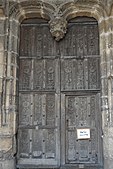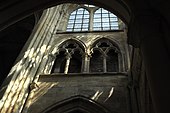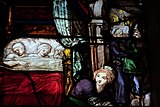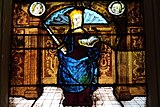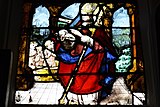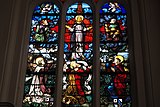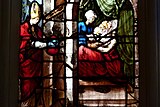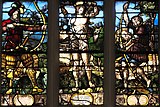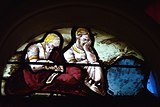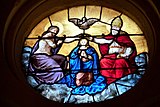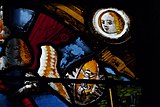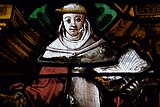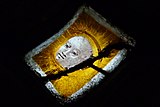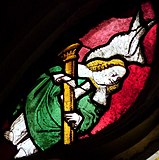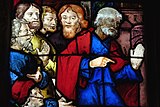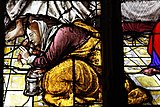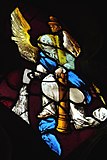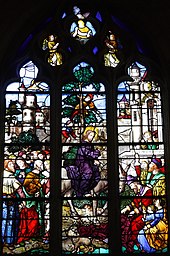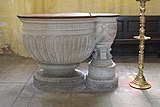St-Martin (Triel-sur-Seine)
The Catholic parish church of Saint-Martin in Triel-sur-Seine , a parish in the Yvelines department in the French region of Île-de-France , was built in the first half of the 13th century on the model of the Notre-Dame Cathedral in Paris in the style of Gothic built. Numerous stained glass windows from the 16th century have been preserved in the church. In 1862, the church consecrated to St. Martin was added to the list of architectural monuments ( Base Mérimée ) in France as Monument historique .
history
In the 13th century the three-aisled nave , the two single-bay transept arms and the original choir were built. The triforium and the upper aisle windows were renewed at the end of the 13th century. At the end of the 15th century, another aisle was added to the south, the north aisle changed and the chapel of the Confrérie de la Charité (brotherhood of Christian love) added to the north-east, next to the choir and the transept . Around 1550 a new choir was built, which joined the old choir in the east, but was shifted one yoke to the north. Under the first yoke of the new choir runs an old path, called chemin du Roi (King's Path ), from which there is access to the crypt below the choir .
architecture
Exterior construction
Nothing is known about the time the four tower was built . It is covered with a hipped roof and was restored in 1910.
In the west of the south aisle there is the portal in an open vestibule. The tympanum from the late 15th century is badly weathered. The wood-carved door leaves were created around 1530 and decorated in the Renaissance style with arabesques, portrait medallions and the coat of arms of the Gallet family.
inner space
The nave, the four western bays of the north aisle and the first south aisle have been preserved from the 13th century church. The two side aisles still have their original vaults, while the original triforium has been preserved in the right arm of the transept .
Leaded glass window
Numerous Renaissance windows are preserved in the church, dating from 1520 to the 1550s. They are attributed to workshops in Paris and Beauvais where the Pinaigrier family and the glass painter Engrand Leprince and his sons Jean and Nicolas worked.
- Chicken Wonder (Window 3)
|
The window tells the story of an innocent man sentenced to death who stayed in a hostel with his parents on the pilgrimage to Santiago de Compostela . Because the maid was rejected by the son, she hid a precious bowl in his luggage. The son is convicted of theft and is to be hanged. After more than thirty days, the parents return from their pilgrimage and find the son still alive on the gallows. They notify the judge who is sitting at the lunch table and who replies to the parents that their son is as alive as the roast chicken on his plate, whereupon the chicken rises from the plate and flaps its wings. The year 1554 is inscribed in the window on the top left. On the lower panes, a monk, a saint with a sword and Saint Nicholas are depicted, who saves the three scholars from the salt barrel. |
- Transfiguration of Christ (window 4)
|
On top of the window of the Transfiguration of Christ , God the Father is depicted, from whom a banner with the inscription “Hic est filius dilectus ...” (this is my beloved son) extends. Next to Jesus, Moses and the prophet Elias , with angels hovering over their heads, are depicted, including the apostles John, Peter and James , at whose feet there is a shell. |
- Saint Nicholas and Saint Maturinus (window 5)
|
Episodes of the legend of St. Nicholas are depicted below on the two-lane window . The scene at the bottom left is reminiscent of the so-called infant miracle, in the scene at the top left you can see St. Nicholas throwing three golden balls through the window into the house of a poor family in order to save their daughters from prostitution. The two right disks show the intervention of the saint during a sea storm. On the upper panes scenes from the legend of St. Maturinus by Larchant are depicted. In the left scene he heals a possessed girl, from whose body a demon escapes, on the right side you can see her parents being baptized. |
- John the Baptist (Window 6)
|
The martyrdom of John the Baptist is depicted on the lower panes and the baptism of Jesus on the upper panes. In the upper part of the two lancets you can see a tape with the inscription: "TU ES FILIUS MEUS DILECTUS IN TE COMPLACUI" (You are my beloved son, in whom I am pleased). The dove of the Holy Spirit hovers on the circular disk above. |
- Saint Sebastian (window 7)
|
On the lower level of the three-lane window, the martyrdom of St. Sebastian is depicted, who is pierced with arrows by two archers. On the upper level you can see St. Rochus on the left , St. Martin in the middle, who shares his cloak with a beggar, and on the right St. Nicholas with the three scholars whom he rescued from the curing barrel. The window is marked with the year 1557. The inscription under St. Sebastian shows that the window was donated by Thomas Mercier, a merchant from Meulan . |
- Adoration of the Magi (Window 8)
|
The central southern choir window depicting the Adoration of the Magi was created in the 19th century. It is marked with the year 1869 and bears the signature: “V. GUILBERT (PARIS) ”. Only the upper panes of the lancets and the tympanum with the depiction of the sermon of John the Baptist date from the 16th century. |
- Root Jesse (window 9)
|
A tree grows from the side of the lying Jesse , between the branches kings of the Old Testament, the ancestors of Jesus, are depicted. King David can be recognized by his harp. The prophets Isaiah and Moses hold banners in their hands that refer to the birth of the Messiah . The window is dated around 1550 and is attributed to the glass painter Jean Leprince. |
- Mary's death (window 10)
|
The death of Mary in the midst of the apostles is shown on the two-lane window . As can be seen from the inscription on the lower edge of the right lancet, the window was donated by the inhabitants of Cheverchemont, now a district of Triel. The coronation of Mary can be seen on the round disc of the tympanum. |
- Ecce homo (window 13)
|
There is an Ecce homo representation in the tracery of the window . The angels on the two side panels hold the scourge column and the cross, underneath you can see the sun and moon. The middle panes depict John the Baptist with the Lamb of God , the conversion of St. Hubert , to whom the crucified one appears in the antlers of a stag, and St. Fiacrius . The donors are presented on the lower panes. |
- Banquet with Simon the Pharisee (window 14)
|
One of the most important windows in the church is the window depicting the banquet at Simon the Pharisee, which is dated around 1520. The scene can be compared to the Last Supper . However, it differs in the presence of Mary Magdalene at the feet of Jesus. |
- Entry into Jerusalem (Window 18)
|
The window depicting the entry into Jerusalem is dated around 1530. In the tracery, angels are depicted with precious clothes. The middle lancet shows Jesus riding a donkey, with Zacchaeus sitting in a tree above it . |
- Window 20
|
The three-lane window is decorated with decorative borders. A round disc, made of grisaille with silver solder, shows a female figure with a scepter and shield, an allegorical representation of bravery (Fortitudo). She sits on a throne with the defeated general Holofernes lying under her feet . There are fragments of architectural representations on the tips of the lancets. Angels making music and a scene with Jesus and the apostles are depicted in the tympanum. On two discs you can see banners with the inscription: “au commencement était le verbe” (in the beginning was the word). |
- Crucifixion window in the aisle (window 22)
|
The window depicting the crucifixion of Christ in the south aisle dates from around 1550. To the right of the cross are Mary ( Stabat mater ) and the apostle John, to the left the soldier Longinus with the holy lance . Mary Magdalene, kneeling, clasps the cross. On the small panes of the tracery you can see the Judas kiss and the apostle Peter cutting off an ear from Malchus with his sword, the sleeping disciples on the Mount of Olives and the mockery of Jesus. |
- Resurrection (window 24)
|
Another window from around 1550 shows the resurrection of Christ. The flagellation, the crowning of thorns and the condemnation by Pontius Pilate can be seen in the windows of the tracery . |
- Crucifixion window in the choir
Another window depicting the crucifixion of Christ is on the high wall of the choir. Blood flows from the wounds of Jesus and is caught in bowls by angels. To the right of the cross stands Mary , to the left the Apostle John . Mary Magdalene kneels at the foot of the cross.
Furnishing
- The colored stone sculpture of St. Vincent is a work from the late 15th or early 16th century.
- The stone figure of a high priest dates from the 16th century.
- The white-framed figure of the Madonna and Child with modern gilding is dated to the late 16th or early 17th century. Mary wears a golden crown on her head, on the hem of her robe set in gold you can read the inscription in golden letters: "AVE DOMINA ANGELORUM" (Hail the mistress of the angels). She is holding a pomegranate in her right hand, and on her left arm is the baby Jesus, who is playing with a dove that is pecking at a berry.
- The marble sculpture of a seated woman with child also dates from the 18th century.
- The baptismal font , which consists of two bowls, is also dated to the 18th century. The wooden lid is from more recent times. The larger basin was used for baptism, the smaller one was used to store the consecrated water. On the upper edge of the larger bowl the inscription is carved: “NISI QUIS RENATUS FUERIT EX AQUA ET SPIRITU SANCTO NON POTEST INTROIRE IN REGNUM DEI” (He who is not born again from the water and the Holy Spirit cannot enter the kingdom of God).
- The wrought-iron, partially gilded lectern dates from the 17th century.
literature
- Louis Grodecki, Françoise Perrot, Jean Taralon (eds.): Les vitraux de Paris, de la région parisienne, de la Picardie et du Nord-Pas-de-Calais . (= Corpus Vitrearum Medii Aevi ). Récensement des vitraux anciens de la France. Volume 1, Éditions du Center National de la Recherche Scientifique, Paris 1978, ISBN 2-222-02263-0 , pp. 136-138.
- Guy-Michel Leproux: Vitraux parisiens de la Renaissance . Délégation à l'Action Artistique de la Ville de Paris (Ed.), Paris 1993, ISBN 2-905118-46-6 .
- Jean-Marie Pérouse de Montclos (ed.): Le Guide du Patrimoine. Île-de-France . Hachette, 2nd edition, Paris 1994, ISBN 2-01-016811-9 , pp. 632-634.
- Georges Poisson (ed.): Dictionnaire des Monuments d'Île-de-France . Editions Hervas, Paris 2001, ISBN 2-84334-002-0 , pp. 801-802.
Web links
- Église Saint-Martin in the Base Mérimée of the French Ministry of Culture (French)
- L'Église Saint-Martin Mairie de Triel-Sur-Seine (accessed on May 15, 2020, in French)
- Église Saint-Martin Observatoire du Patrimoine Religieux
- Église Saint-Germain d'Auxerre à Coignières Sortir en Yvelines (Département des Yvelines)
Individual evidence
- ↑ Leaded glass window from the 16th century in the Base Palissy of the French Ministry of Culture (French)
- ↑ Église Saint-Martin in the Base Mérimée of the French Ministry of Culture (French)
- ↑ Saint Vincent in the Base Palissy of the French Ministry of Culture (French)
- ^ High priest in the Base Palissy of the French Ministry of Culture (French)
- ↑ Madonna and Child in Base Palissy of the French Ministry of Culture (French)
- ↑ Seated woman with child in Base Palissy of the French Ministry of Culture (French)
- ↑ Baptismal font in the Base Palissy of the French Ministry of Culture (French)
- ↑ Lectern in the Base Palissy of the French Ministry of Culture (French)
Coordinates: 48 ° 58 ′ 57.5 ″ N , 2 ° 0 ′ 9.9 ″ E



